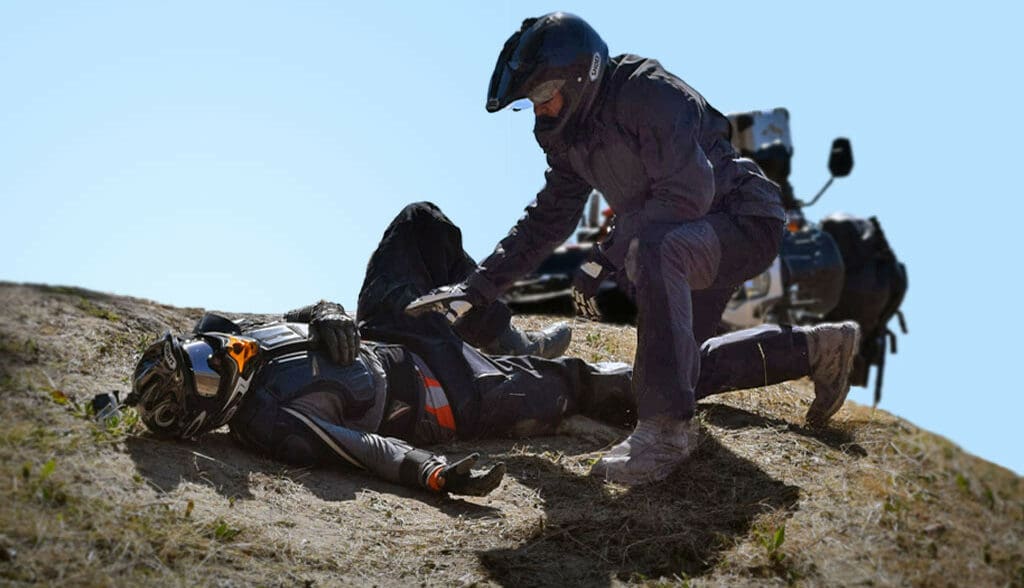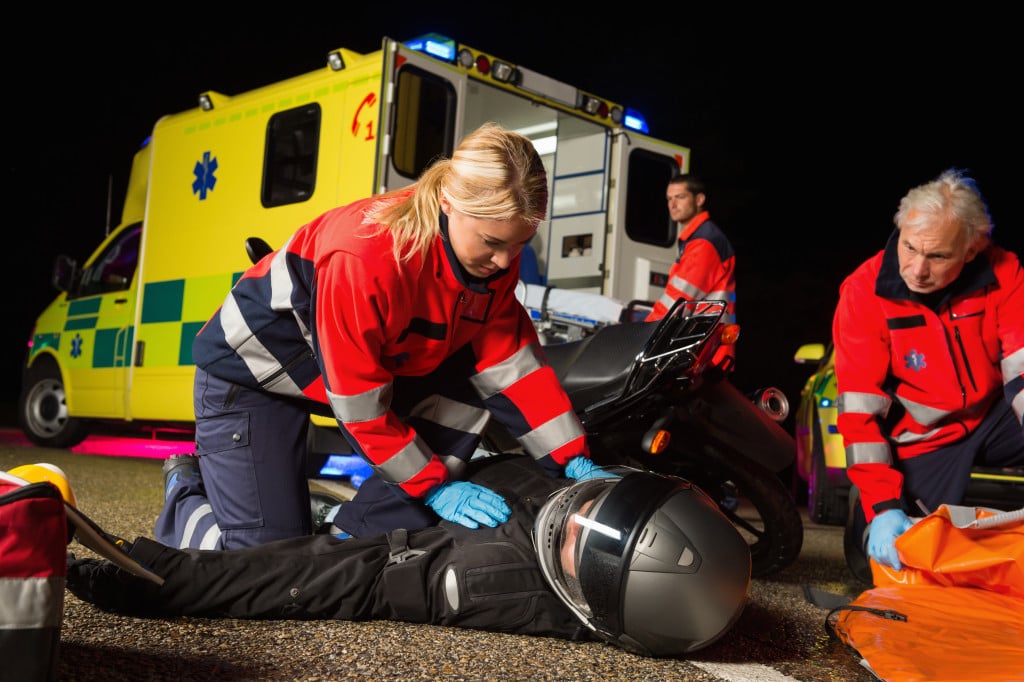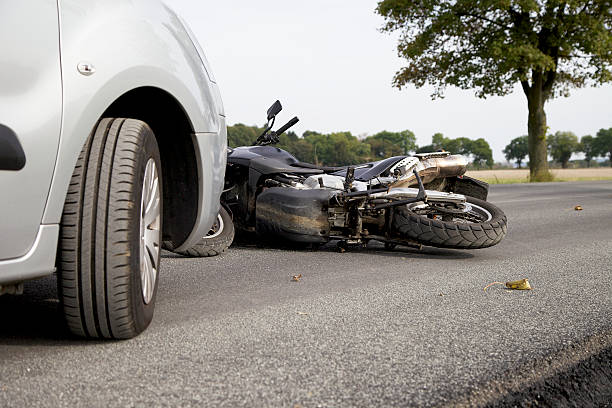**This article was written in collaboration with Road Guardians, an organization dedicated to teaching motorcyclist first aid and accident scene management. While we consulted with experts, every situation is different. In the event of an injury, it is best to contact emergency services and follow their instructions.
To be blunt right off the top, according to the Insurance Information Institute of America, in 2018, the latest year that they have information for, out of 8.6 million registered motorcycles, there were approximately 82,000 injury accidents. This equates to just under 1% of those 8.6 million registered motorcycles.
Being even blunter, of those 8.6 million motorcycles, there were just under 5,000 fatal accidents. Of those fatalities, the worrying statistic is that if the appropriate medical intervention had been applied sooner, some of those riders would still be alive. There were bleed-outs, traumatic cardiac arrests, the rider moving and cutting their spinal cord doing so, and the like.
We state this not to be overly graphic. In fact, we are sharing these statistics to reinforce a simple fact: Having proper, certified first aid training can help you save a fellow motorcyclist’s life. All it takes, really, is a weekend course and constant vigilance. However, even the most basic knowledge, even without taking a course, can still help.
It is, for this reason, we have teamed up with Road Guardians, an organization dedicated to teaching motorcyclist first aid and accident scene management, to pass along some important knowledge that every motorcyclist, first aid trained or not, should learn. As you, the reader, know, one of webBikeWorld’s main objectives is to promote rider safety and ensure that everyone gets a chance, if they had an accident, to swing a leg over their bike again.
The Most Important Rule
There is one overriding rule about a downed rider that everyone should know:
Don’t remove the helmet unless it is interfering with breathing.
While there are exceptions to every rule, if you come upon a downed rider that is breathing, leave the helmet on. Don’t unbuckle it, don’t lift the chin bar of a modular, leave it where it is. The reason for this is twofold. First, because of how motorcycle helmets are usually shaped, if the rider is lying on their back, the helmet is actually supporting a good spinal position to protect the neck.
Second, helmets are, again by design, tightly fitting things. Pulling a helmet off can pull the neck and spine, so if the helmet is not causing any discomfort or is getting in the way of any treatment of the downed rider, leaving it on is the safest course of action.
The only two exceptions to the rule are if the downed rider is not breathing, or the helmet is trapped and you need to move the rider away from danger such as a chemical spill, fire, or other life-or-death situation. If you must remove the helmet, support the riders’ head and neck in as neutral a position as possible, and support it continuously as you remove the helmet.
PACT
With special thanks to Road Guardians, knowing this acronym will allow you to quickly and effectively control an accident scene and render aid to a downed rider.
PACT stands for:
- Prevent further injury
- Assess the situation
- Contact EMS
- Treat the injured rider
The first two you can do as you pull over to the accident scene. Preventing further injury by creating a safe space scene. Consider whether or not you can leave the injured where they are. If it is unsafe for them, you may need to move them off the road or direct traffic around them. Once the scene is controlled, and, if safe to do so, moving damaged vehicles off the roadway also helps create a barrier between oncoming traffic and the downed rider that has been moved to the shoulder. To determine if it’s safe, you need to assess as you respond to the downed rider, such as scanning the environment for hazards, noting anything in that environment that could also have contributed to injury such as a concrete median divider if the rider is down on the inside shoulder, and the like.
Assess the situation at the same time that you Contact EMS, if you have a cell phone signal. You will need to do a quick check of the downed rider for immediate signs of life-threatening injury. If they are conscious and breathing, ask them their name, the day, where they are. Next, scan them quickly for serious bleeding. Ask quick, easy to answer questions, and note if they reply correctly or not. Do a quick “wiggle test,” namely “Can you wiggle your fingers and toes? Any sharp pains anywhere as you do that?”
If you do not have a cell phone signal and you find life-threatening injuries, you might not be able to leave to get help. Regardless, knowing what to tell a dispatcher once you have called for help will help them prepare while in transit. If others have stopped to help, assign one of them to call EMS and pass along the simple results of your questions. “Hey you, call 9-1-1, tell them where we are, and this rider doesn’t know where he is, and has sharp pains in his left leg if he tries to move it.” Quick, effective communication that gives the responders critical information.
On the last item, that being treating the injured rider, there is another acronym to know
ABCSS
Easy to remember by putting it in the sentence “the ABCSS of treatment,” this covers the five most vital, lifesaving criteria of treatment:
- Airway
- Breathing
- Circulation (Bleeding)
- Shock
- Spinal
The first two go hand in hand, and should also be part of your assessment if the downed rider is unconscious when you arrive. Check to make sure their airway is not compromised, and check for breathing. If they are not breathing, are wearing a full-face helmet that interferes with opening their airway, remove the helmet carefully. Lift the tongue off the back of the throat using a jaw thrust maneuver if you know how, or carefully perform a head tilt chin lift. If the injured rider does not resume breathing on their own with their airway clear, begin rescue breathing by giving two breaths initially, then one every six (6) seconds. Having a rescue breathing barrier, such as a collapsible rescue breathing mask, on you at all times is highly recommended. Especially in 2020 and 2021, you are not expected to put your mouth directly over a strangers mouth except in the most extreme of cases.
Circulation is the next most important. Blood is literally the water of life. Bleeding slowly from a scrape or surface cut is not immediately vital, but a laceration with significant blood flow is. The best way to stop bleeding, or slow it down long enough that emergency responders can take over, is pressure. You may need to put a very uncomfortable amount of pressure on a laceration to slow or stop the bleeding. If pressure is not stopping or slowing the bleeding on an arm or a leg, a tourniquet needs to be applied. These can be anything with enough strength to be tied very tightly around the limb and can be everything from a belt, to a wide folded triangle bandage, to a dedicated tourniquet strap with a tightening handle. The tourniquet needs to be about 2 inches above the top of the bleeding wound. The tourniquet should be tight enough to stop the bleeding. It will also most certainly hurt, so inform the downed rider, if they are conscious, honestly. “This is going to hurt like hell, but it will save your life.”
Shock will most likely follow any immediate treatments. To treat shock, if possible cover the downed rider with an emergency blanket or with your own jacket to provide extra warmth. Allow them to assume a position of comfort. The best thing is to keep them awake and warm. Ask questions that you would like answers to should they fall unconscious such as: Where does it hurt? Is there someone I can call for you? Do you have any allergies? Are you on any medications? Do you have any past medical issues I should be aware of? When was the last time you had anything to eat or drink? Do you remember what happened right before your crash? Questions like these are engaging the injured riders’ mind, and keeping them awake while you also learn valuable information.
If you suspect a spinal issue, reassure the downed rider that help is coming, and brace their head between your hands from above their head. This is most easily done by kneeling with your knees just back from the top of their head, put your wrists against your knees, and hold their helmet with your palms. As you do so, keep informing the downed rider what you are doing, and reassure them that you are doing this to help, as well as a reminder for them to remain as still as possible.
DO NOT pull on the helmet, turn the head, or push forwards with any force. You are only providing external support to prevent the head from rolling side to side and up and down. The spine of the downed rider will handle the alignment of the spine and spinal cord.
With special thanks to Road Guardians, they have provided a printable “Cheat sheet” you can toss in your wallet, riding jacket pocket, or first aid kit. This is so that if your mind is racing when you come across an accident, you will have a physical fallback to help you focus. It also includes a reminder of the questions you should ask while waiting for EMS to arrive. You can download it here:
Take A First Aid Course
One of the things we say about motorcycling as a whole is “dress for the slide, not for the ride,” or, in the much more familiar terminology, “All The Gear, All The Time.” So it’s only reasonable to also dress your mind and knowledge in that same level of gear.
Road Guardians themselves hold multiple training courses throughout the year, which are taught by experienced riders who also are paramedics, nurses, and the like. As part of the training, you will also get to practice accident scene management (the PACT acronym), learn how to do a rapid assessment of a downed rider, how to move an injured rider properly and with correct support, jaw thrust rescue breathing, pressure dressings, tourniquets, and much more.
The American Red Cross also provides weekend courses for multiple levels of first aid, from basic first aid through to advanced CPR.
St. John’s Ambulance provides training in the US, Canada, the UK, and many other nations around the world.
Also, check to see if your local continuing education providers have basic first aid courses you can do on evenings and weekends.
Much like the gear we all wear when riding, it’s better to have it and never need it, than to need it and not have it. Get trained. Get certified. Ride prepared to help other riders. We are one community, no matter how diverse and spread out. Riders help riders.




